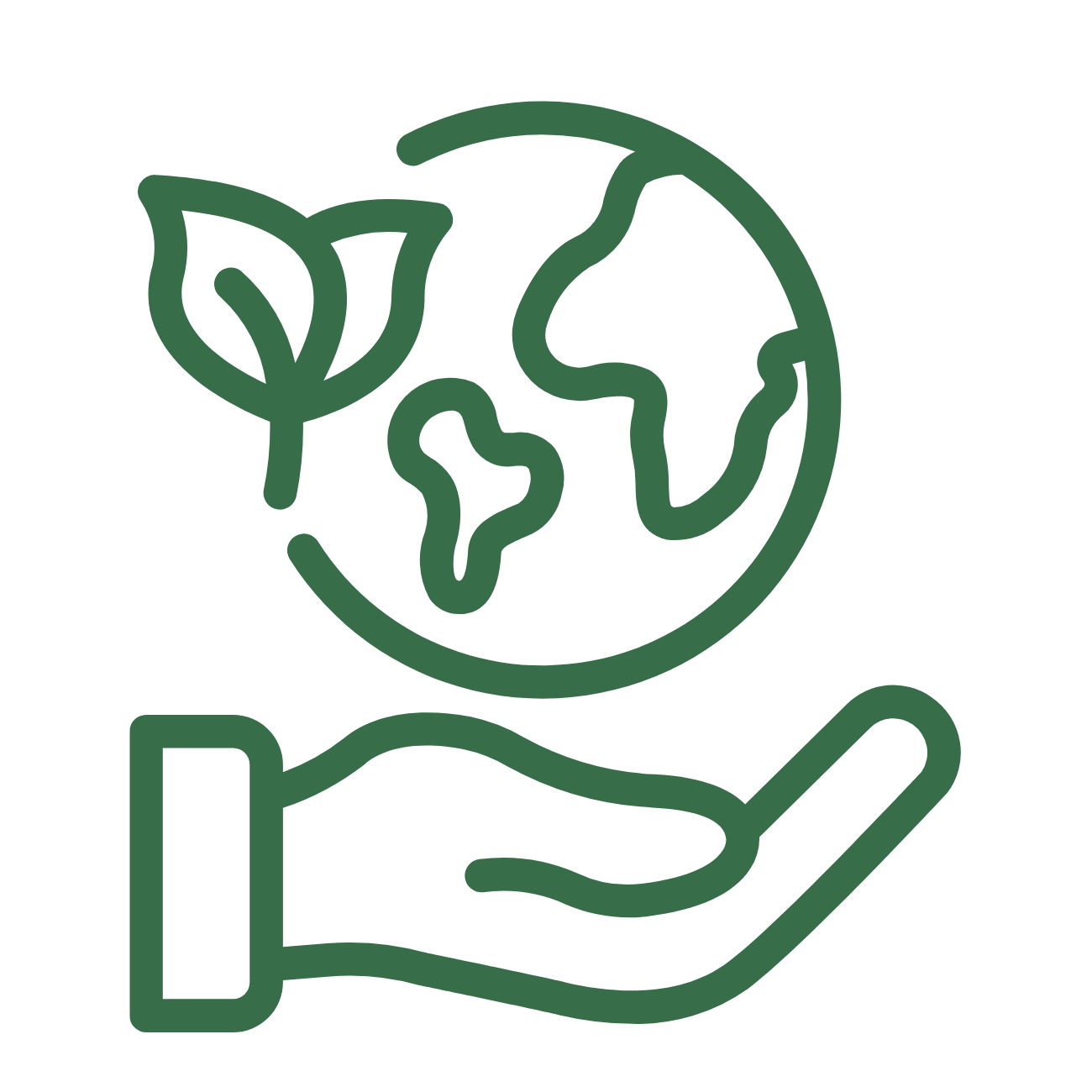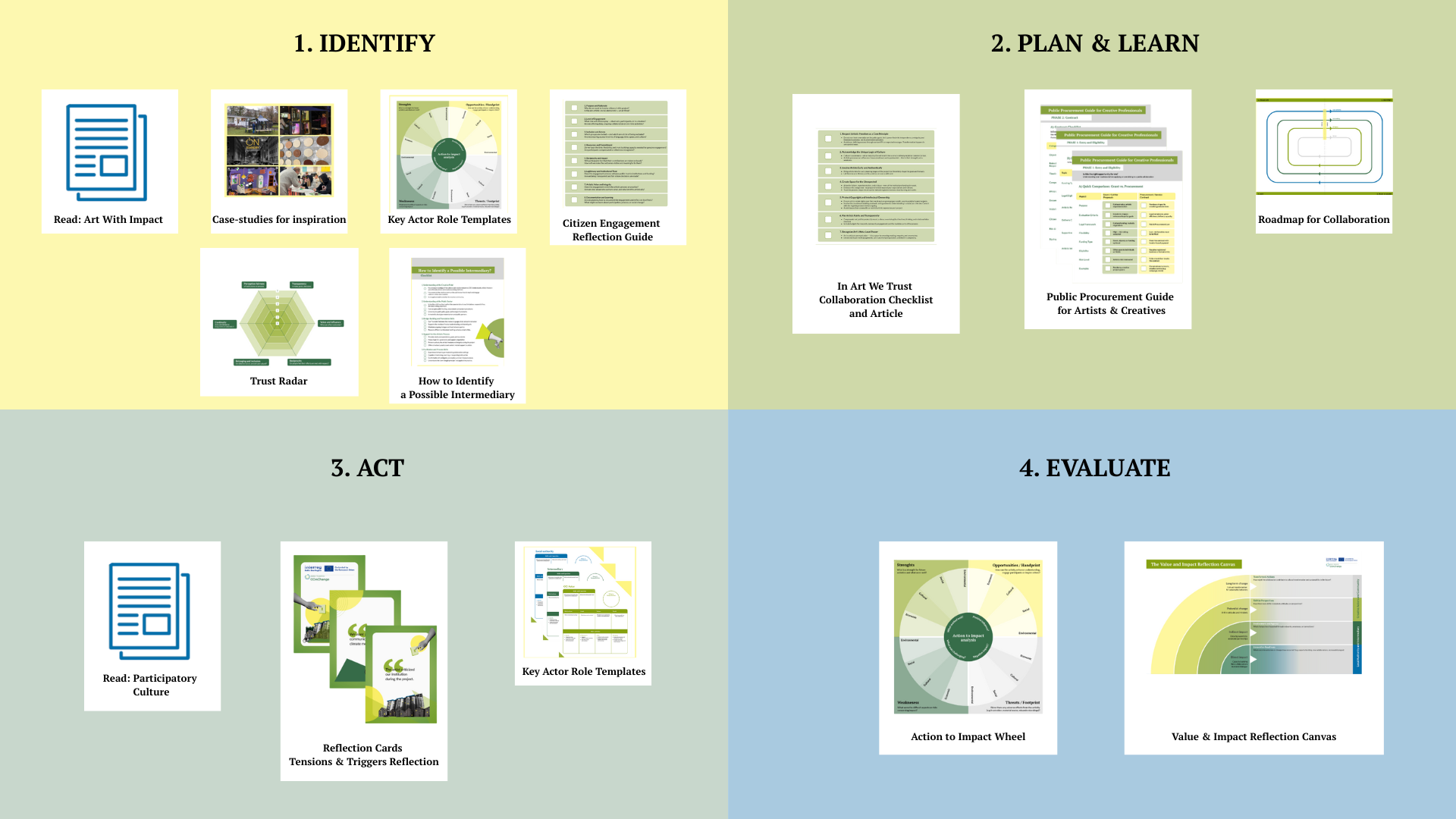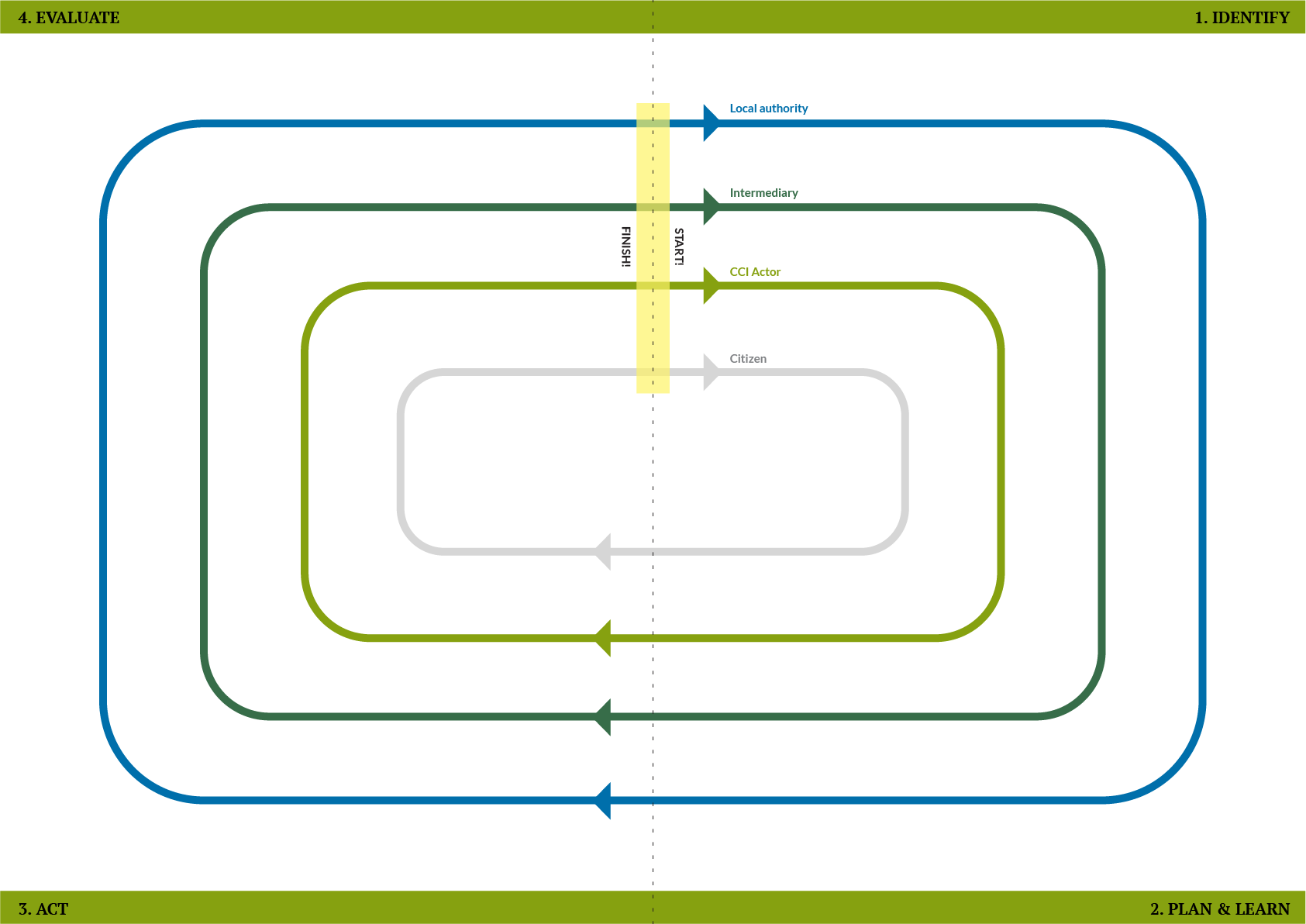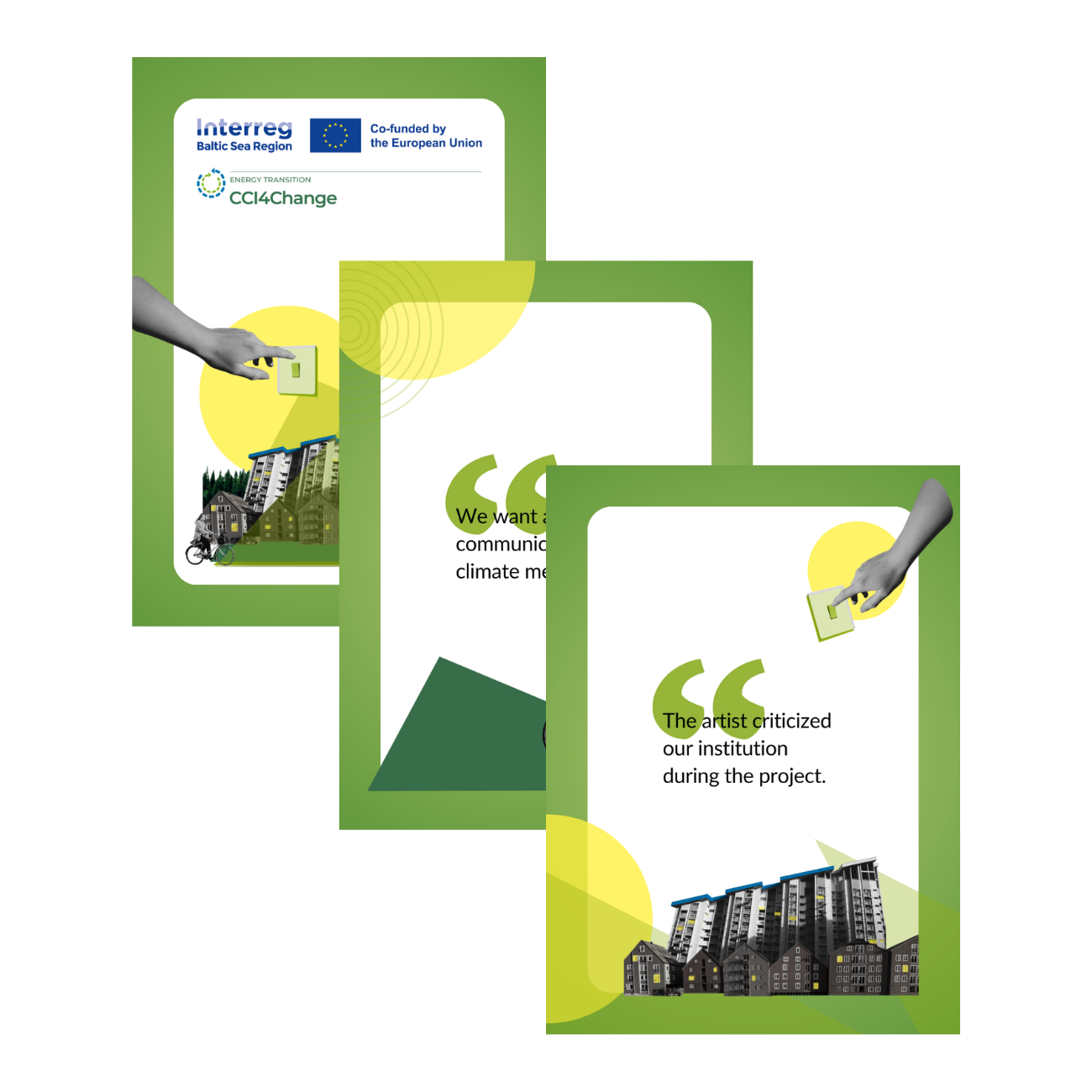Please note: Parts of this website will be included in the forthcoming CCI4Change publication, to be released by Xamk in December 2025. Therefore, if you wish to cite this material, please contact cai.weaver[at]xamk.fi. Thank you!
How Can Creative Professionals Drive Change?
Make a Difference Through Your Creativity
As a creative professional, you have a lot to contribute, and your creativity and professional skills can both drive and support meaningful change. Creative ideas and approaches like yours can drive the sustainability transition and foster deeper community engagement beyond the reach of more traditional methods. By building new partnerships to work more cross-sectorial and alongside public authorities, you can expand the means for your work to have a positive impact.
This toolkit introduces a collaboration model, developed as part of the CCI4Change project, is a practical framework designed to inspire and guide collaborative action on climate change through artistic and creative processes. At the heart of the model lies a powerful idea: art has the ability to drive transformation and serve as a source for change. When people engage with artistic experiences, they are emotionally and intellectually moved – and this can spark meaningful change in attitudes and behaviours.
Your Creative Projects Can:

Raise the awareness about sustainability issues!

Build artistic experiences around issues that matter!

Facilitate participation
and co-creation with communities!

Inspire people to think and act differently!

Contribute trough creative skills to cross-sectoral collaborations!

-and so much more!

Explore the creative case-studies and get inspired here
Collaboration Model
The CCI4Change collaboration model aims to support partnerships between creative professionals and public authorities (officers at municipalities, cities and regions) to partner up, collaborate and enable creative climate actions for the wanted change. This visual model below outlines the collaboration journey – illustrating how creative professionals, intermediaries, and local authorities can join forces and work together toward a joint goal. It highlights the key phases of the CCI4Change process, the roles and actions of the collaborators, and the tools available to support each step.
We invite you to use this toolkit and initiate creative climate action within your local community — and, when collaborating with the local authority, to use the tools as a practical resource to build stronger dialogue in the collaboration, with clear goals and purpose. The toolkit can be adapted to various contexts of climate action, sustainability goals, and social settings where artistic and creative approaches are included to address complex community challenges. In the CCI4Change project we worked with the goal of energy consumption behavioral change.
Explore the Toolkit on a desktop computer to access the full version and all materials!

Summary of Tools:

Begin by identifying a local climate or energy-related challenge that feels relevant in your community. Rethink the issue and consider what creative and artistic approaches might achieve that traditional methods cannot. Elaborate on your own motivations to work towards this cause, in what way is it inspiring?
STEPS:
1. Identify a concrete local climate or energy challenge. Think about how this issue is felt in everyday life, how you relate to it, and how working with it motivates you.
2. Ask yourself: What can creative approaches and the arts contribute to addressing this issue—something that facts alone cannot achieve? Consider which competencies and creative methods could be relevant.
3. Map possible stakeholders in your local area and region: Which specific communities could be involved? Consider involving citizens as early as possible to ensure relevance and shared ownership.
4. Identify an intermediary! A collaboration with the creatives can benefit from an external intermediary party. Which organisation in your local community could serve as an intermediary party, support the initiation of a CCI4Change process and build bridges towards the public officials?

TOOLS:
Article: Art With Impact – Leveraging Culture for Green Transformation
Discussions around the green transition often focus on technical solutions or political strategies. But without cultural transformation - without shifts in meaning, value, and identity - such efforts risk addressing symptoms while the deeper logic remains unchanged. Art does not have all the answers. But it can ask questions no one else dares to ask. It can reveal contradictions, open space for new visions, and create experiences that dissolve the boundaries between self, society, and environment. Most importantly, it can help us imagine - and feel - what a sustainable future might look like, not just in terms of metrics, but in terms of life.

Case-studies for inspiration
The case studies in the CCI4Change project showcase real-life pilot projects carried out in Finland, Latvia, and Sweden. Each case involved collaboration between local authorities, intermediaries and creative professionals to explore new, artistic ways to reduce energy consumption and engage local communities.

Action to Impact Wheel
Action to Impact Wheel is a practical tool that supports creative teams in understanding how their activities translate into real-world impact. It is based on sustainability thinking and inspired by the familiar SWOT model (Strengths, Weaknesses, Opportunities, Threats), but adapted with a focus on the broader dimensions of sustainable development.
The tool encourages users to consider the link between their actions and impact, especially in the context of the UN Sustainability Development Goals (SDG). It helps you explore how creative actions support or challenge sustainability — both locally and globally.
Capacity Builder for Creative Climate Collaboration
This guide helps local authorities work more confidently and effectively with artists in public-sector, sustainability- or citizen-focused projects.
It supports you in:
-
Choosing the right commissioning model (grant or procurement)
-
Designing artist-friendly and goal-oriented open calls
-
Building clear, fair and transparent contracts
-
Creating better outcomes through mutual understanding

Citizen engagement reflection guide
This tool helps cultural and creative project partners reflect on the meaning, design, and impact of citizen engagement. Citizen engagement in this context is not simply about participation as audience, but active involvement in shaping the process and outcomes.
Download PDF

Trust Radar
Trust Radar is a simple yet powerful tool designed to help actors understand and strengthen trust in collaborative and participatory projects. It offers a structured way to reflect on how trust is perceived and experienced among different actors — especially in socially engaged, cross-sectoral, or creative processes.
Rooted in Nordic traditions of transparency, inclusion, and mutual recognition, the tool can be used at different phases of a project: during planning, mid-point check-ins, or final evaluations.

How to Identify a Possible Intermediary
Creative climate action collaborations and creative-public collaborations in general, the intermediary plays a crucial bridging role between local authorities and professionals from the culture and creative industries (CCI). This function supports trust-building, communication, and process facilitation — ensuring that both public-sector goals and artistic integrity are respected.
In CCI4Change, the collaboration is led by the local authority, which initiates the collaboration by organizing an open call or procurement process for creatives to propose their activities for creative climate actions. In this phase, the creatives plan their creative project and respond to the open call - thereafter a practical collaboration is established between the creative actor and the local authority.
The collaboration should be organised in a clear and structured way, and open dialogue is key to making it work for everyone involved. It's important to find common ground and set shared expectations and define each party’s role in the collaboration. An intermediary can help by acting as a facilitator and making sure the process runs smoothly for everyone.
STEPS:
1. Build your capacity, and if possible, join capacity building sessions offered by the local authority or intermediary as part of the CCI4Change process.
2. Stay tuned for the local authority open call and the criteria announced for the collaboration. Submit a clear and well-structured project proposal, Identify the communities you intend to engage, and describe the expected outcomes of your activities.
3. Plan for citizen engagement with specific communities. Ensure access and real involvement, and how the participation can play an important role in making the project a success.
4. When starting the collaboration with the public authority, support the need of clarifying roles and responsibilities of the different parties and discuss shared expectations for the work. Plan how you intend to evaluate, document and communicate about your project.
5. Support the public authority and intermediary in setting up needed contracts. Give your input and expertise to ensure the agreement is fair and transparent to all parties.

TOOLS:
In Art We Trust – Collaboration Checklist and Article
This checklist-based tool supports fair, respectful, and effective collaboration between public authorities, intermediaries, and artists working on impactful projects. It is rooted in the recognition that art and culture offer unique ways of addressing complex challenges—and that this potential can only be realized if artistic freedom and cultural logic are preserved.

Public Procurement Guide for Artists & Creatives
This two-phase tool supports artists and cultural professionals preparing for publicly funded collaborations such as the CCI4Change involving municipalities and citizen engagement. It supports reflection and planning before applying and before signing a contract, addressing both creative fit and legal clarity.
The canvas integrates insights from grants vs. procurement structures and contract checklists to empower creatives to work confidently in institutional settings without compromising artistic integrity.

Citizen engagement reflection guide
This tool helps cultural and creative project partners reflect on the meaning, design, and impact of citizen engagement. Citizen engagement in this context is not simply about participation as audience, but active involvement in shaping the process and outcomes.

Roadmap for Collaboration
Roadmap for Collaboration is a step-by-step method that outlines how different actors are connected and how the actions of one stakeholder can trigger actions by others. The tool is designed for cross-sectoral collaboration, especially in the context of creative climate action, and was developed within the CCI4Change project.
The roadmap is based on a service blueprint method, adapted to clarify roles, actions, and timing in joint projects. It visualizes how local authorities (as project leads), intermediaries, creative actors, and citizens progress through a collaborative process together. The roadmap highlights each role’s contributions along a shared timeline and helps ensure synchronized progress.
Your project plan for creative climate actions was drafted and approved in the previous phase, and now it’s time to put it into action! In this phase, you’ll use your artistic or creative skills while working together with communities. This collaboration needs careful planning to make sure people can take part and that the experience is positive and meaningful for everyone involved.
STEPS:
1. Carry out your creative project as you drafted in the plan with engagement of communities.
2. Make sure you have a plan to engage with communities, clearly outlining what’s expected from the community groups involved in your project with all practicalities taken into consideration.
3. Keep the local authority updated about your work. Agree how the local authority can be of support to your work (spaces, communications, permits etc.). Be mindful of the timelines and communicate about your needs well in advance.
4. Plan documentation and share the responsibilities with the public authority or intermediary parties. Share the story within your networks, and provide communication materials for the local authority to use in their channels. Be respectful of photography permits when working with communities.
5. Prepare for actions of gathering feedback and evaluation of the project.
6. Be prepared for changes. A creative process comes always with suprises, and the work with communities is complex. Have an open mind and explore the process and seek for support from the local authority and intermediary parties!

TOOLS:
Article: Participatory Culture
“Participatory” – it’s a tricky word, but by the time you’ve learned how to pronounce it, you’ve probably also begun to understand what it means. On an informal level, the phenomenon has likely existed since the first groups of Homo sapiens wandered along the shores of the African continent. Humans are social creatures, and various forms of collaboration, ownership, and collectivism are deeply rooted in our DNA (just like less flattering traits such as egoism, racism, and a propensity for violence…). That said, the term participatory culture is a more recent invention.

Reflection Cards – Tensions & Triggers Reflection
The Reflection Cards: Tensions & Triggers is a discussion-based tool designed to explore and address sensitive dilemmas that may arise in collaborative cultural projects. It focuses on situations where local authorities, artists, intermediaries, and civil society actors work together — but experience friction.
Each card presents a real-world tension or triggering situation related to artistic freedom, institutional expectations, or public reaction. The purpose is not to solve these dilemmas in a standardized way, but to create space for honest reflection, strengthen mutual understanding, and build more resilient partnerships.
This tool is grounded in the principle that art must remain free and that intellectual property rights are fundamental, not only for democratic integrity but also for artists’ livelihoods.

Key Actor Role Templates
The tool supports key actors of collaboration to understand the different roles the project entails, key activities and contributions. The tool is useful especially in the planning phase of the project, to clarify the responsibilities of each actor Each key actor in the Creative Climate Action at CCI4Change —such as a local authority, an intermediary, and or a creative sector actor—has their own template to fill in. The template guides the user in outlining their specific responsibilities and perspectives within the collaboration.
In this phase, the creative project has been concluded, and it is time to reflect on the process, evaluate how the work was meaningful, and plan for its legacy. This is also the phase when we communicate about the work, and create the story of how creative climate actions make sense. In this phase it is important to elaborate on the value of the collaboration and the potential impacts with the different parties. It is also beneficial to take note on what worked well in the collaboration, what was less successful, how we could improve - and how this experience paves the way for future actions.
STEPS:
1. Engage the community in gathering of feedback and carrying out participatory evaluation. Be mindful of the knowledge you collect and what approach you take to show value and impacts of the collaboration. Be creative!
2. Share results of the received feedback with the public authority and all stakeholders. This way, you ensure they can use the feedback to support future projects of a similar kinds.
3. Reflect the collaboration process together with the public authority and the intermediary party: Were the expectations met? What worked well and what could be improved? What was interesting and created meaning?
4. Explore possibilities for scaling or repeating. Elaborate what in your project could be worthy to revise and how you would develop your project approach and concept. Seek for potential new collaborators or expansions of the collaboration with the public authority or intermediary.

TOOLS:
Action to Impact Wheel
Action to Impact Wheel is a practical tool that supports creative teams in understanding how their activities translate into real-world impact. It is based on sustainability thinking and inspired by the familiar SWOT model (Strengths, Weaknesses, Opportunities, Threats), but adapted with a focus on the broader dimensions of sustainable development.
The tool encourages users to consider the link between their actions and impact, especially in the context of the UN Sustainability Development Goals (SDG). It helps you explore how creative actions support or challenge sustainability — both locally and globally.

Value and Impact Reflection Canvas
The Value & Impact Reflection Canvas is a tool designed to help collaborators reflect on and articulate the different dimensions of value and impact that emerge from cultural collaborations. It acknowledges that many of these impacts are subtle, long-term, and difficult to measure, yet no less meaningful or essential.
This tool is especially useful in contexts like CCI4Change, where the effects are embedded in relationships, mindsets, narratives, and new connections rather than in immediate quantitative results. It supports shared understanding between stakeholders by prompting discussion on what kind of impacts are expected, what might be explored or tracked, and which forms of value should be acknowledged, even if they cannot be measured directly.
1. Identify
Purpose:
Begin by identifying your interest in creative climate action.Think your creative processes, how you could engage communities through your art or creativeness. How your art could touch people and make them behave differently.
Steps:
1. Identify your interest in creative climate action.
2. Benchmark other creatives who has involved in public procurement
3. Read case studies, how artist did in our case?
Key tools:
Action to Impact Canvas
Tips for Co-Creation
Tips for Citizen Engagement
2. Plan & Learn
Purpose:
Develop skills and plan your project
Steps for participants:
1. Participate capacity building sessions
2. Learn about procurement processes and contracts
3. Learn about sustainability
4. Create a project plan & budget
5. Update CV & portfolio
Key tools:
Public procurement guide for Artists & Creatives
Tips for Visibility strategies
Tips fof Documenting & feedback
3. Act
Purpose:
Launch creative projects and engage communities.
Steps:
1. Make contracts
2. Implement artistic activities and participatory actions with the community
3. Clarify your role in the project
4. Document your process
Key tools:
Roadmap for collaboration
Key actor template
Contract guide & templateTips for Documentation and feedback
4. Evaluate
Purpose:
Reflect on the process, participate on evaluation
Steps:
1. Conduct participatory evaluation
2. Share results
3. Explore possibilities for scaling or repeating
Key tools:
Value and impact frameworks
Action to Impact Canvas (revisited and updated)







